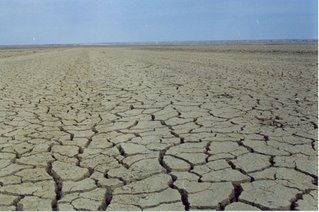And by the way... We aren't the ONLY ones being invaded...
"About 40 percent of the nation's rivers and 46 percent of its lakes are too polluted for fishing and swimming. Wetlands, the biological filters for water pollution, are shrinking by 100,000 acres a year, mainly because of development. Roughly 6,700 species in the country are at risk of extinction, most often because of habitat loss. Half of the continental United States no longer supports native vegetation, largely because people have altered the terrain significantly.
Last year, one of every five immigrants worldwide lived in the United States, according to a May report by the United Nations. Immigrants also play a key role in population growth once they arrive in the United States. Latinos have the nation's highest birthrates among major population groups, the report showed."
**
U.S. population growth and its effects on our environment must be addressed, experts say.
By Mike Lee UNION-TRIBUNE STAFF WRITER
August 6, 2006
CRAIG MAYHEW ANDROBERT SIMMON / NASA GSFC
Look at the top-priority campaigns of the nation's big environmental groups and you'll find endangered animals, pollution and global warming.
What's largely missing are high-profile, domestic initiatives that tackle what many conservationists agree is a chief source of these and other challenges: U.S. population growth.
The environmental establishment has mostly abandoned talking about the nation's growing populace, particularly as it relates to immigration. The topic is dogged by internal squabbles, divisive politics and a desire to avoid ethnic discrimination.
One result is that ecological factors are rarely mentioned in the current effort to establish a new immigration policy. The debate mostly centers on economics and national security.
“People have been avoiding it like the plague,” said U.S. Rep. Brian Bilbray, R-Carlsbad, a hawk on illegal-immigration issues.
“(Environmentalists) will sidestep major challenges to what their stated goal is because it may end up stepping on political friends' toes,” he said. “They have credibility problems when they are willing to look the other way.”
August 6, 2006
CRAIG MAYHEW ANDROBERT SIMMON / NASA GSFC
Look at the top-priority campaigns of the nation's big environmental groups and you'll find endangered animals, pollution and global warming.
What's largely missing are high-profile, domestic initiatives that tackle what many conservationists agree is a chief source of these and other challenges: U.S. population growth.
The environmental establishment has mostly abandoned talking about the nation's growing populace, particularly as it relates to immigration. The topic is dogged by internal squabbles, divisive politics and a desire to avoid ethnic discrimination.
One result is that ecological factors are rarely mentioned in the current effort to establish a new immigration policy. The debate mostly centers on economics and national security.
“People have been avoiding it like the plague,” said U.S. Rep. Brian Bilbray, R-Carlsbad, a hawk on illegal-immigration issues.
“(Environmentalists) will sidestep major challenges to what their stated goal is because it may end up stepping on political friends' toes,” he said. “They have credibility problems when they are willing to look the other way.”
**
Go here to read it all - some really good graphics and charts.


1 Comments:
Well stated. Conservationists most of all sidestep the issue here. More people = more development, less pristine land, and more pollution. Saving a few thousand acres here and there from development is like putting a wad of bubble gun on a major river dam breach.
If environmentalists really want to save polar bears, they need to expose ZERO population growth for the US and the entire world.
Post a Comment
<< Home